Art World
So Bad They’re Brilliant? See the 17 Most Bizarre and Completely Outlandish Art Restoration Fails of All Time
"Beast Jesus" is not the only well-intentioned restoration job gone horribly, horribly wrong.
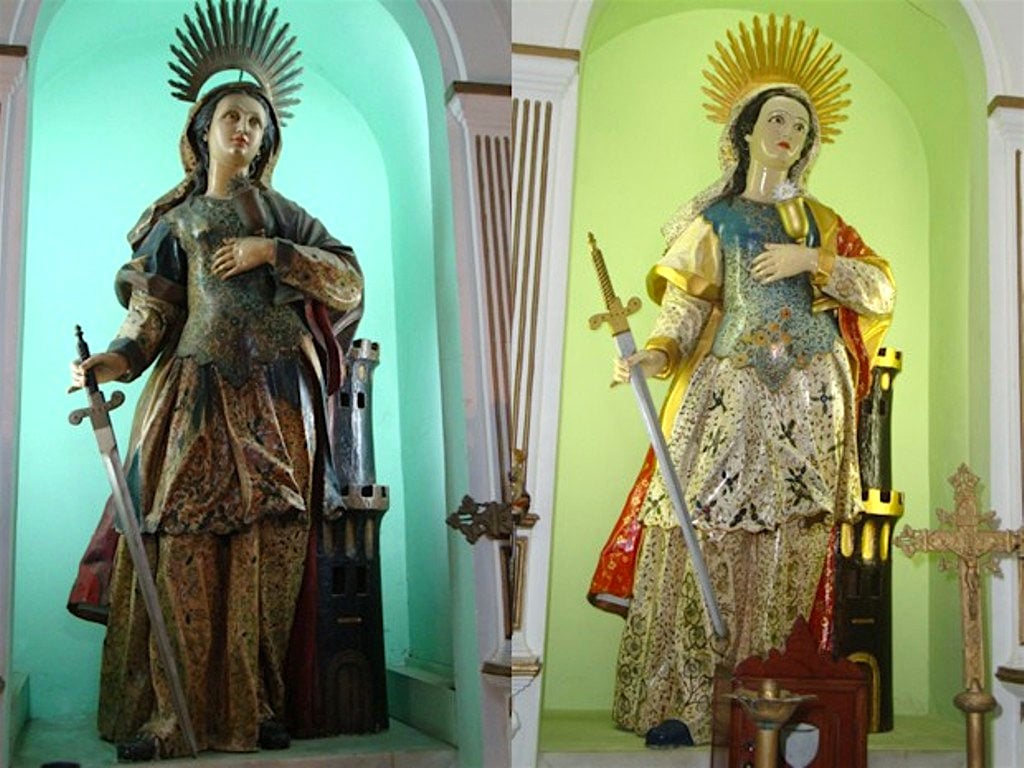
"Beast Jesus" is not the only well-intentioned restoration job gone horribly, horribly wrong.

Sarah Cascone

Restoration is an art unto itself, helping preserve art history’s greatest masterpieces for posterity. But for every job well done, there are others that meet a critical eye—experts were famously divided over the bright colors revealed in Michelangelo’s Sistine Chapel in Rome by work done between 1980 and 1994, for instance. And still others end in outright disaster.
Here are some of the world’s most infamous restoration fails.

Leonardo da Vinci, The Virgin and Child with St. Anne (1503), before and after restoration. Photo courtesy of the Louvre, Paris.
When the Louvre restored Leonardo da Vinci’s The Virgin and Child With Saint Anne (1503), removing centuries of dirt and discoloration, the change to the painting was dramatic—so much so that two conservation experts on the panel advising the restoration resigned in protest over the methods used to clean it.
Concerns that those mistakes might be repeated arose in 2016 as the Louvre prepared to begin work on the Renaissance artist’s 1513 masterpiece St. John the Baptist, which had not been cleaned since 1802. But after nine months of work, details in the saint’s hair and clothing, lost beneath 15 layers of varnish, reemerged, restoring the artist’s delicate handiwork.
In 2014, the Egyptian government came under fire for its restoration of the country’s oldest pyramid, which was built for the Old Kingdom pharaoh Djoser. Although government officials denied that there was any problem, critics said the work had damaged the facade of the ancient site, prompting the UNESCO World Heritage Center to launch an investigation into the work.
It all seems to have worked out in the end, however, as the BBC published an article this April crediting the British engineering firm Cintec with saving the stepped stone building from ruin.
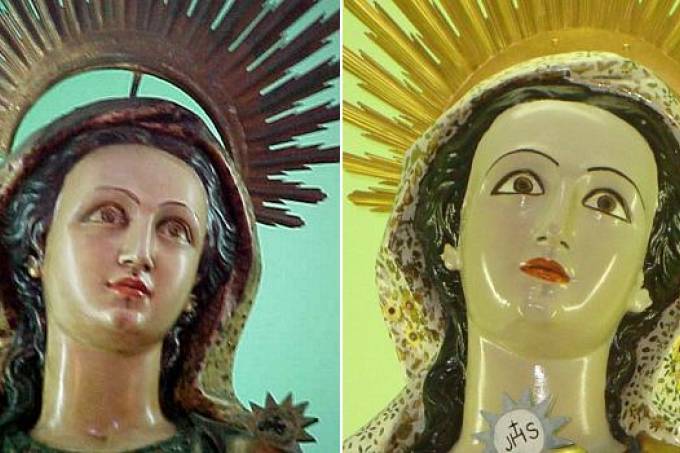
The statue of Santa Barbara at Brazil’s Santa Cruz da Barra Chapel before and after restoration. Photo by Milton Teixeira.
Historian Milton Teixeira was shocked to discover that an overzealous restorer had tarted up the statue of Santa Barbara at Brazil’s Santa Cruz da Barra Chapel in 2012. The dramatic makeover had given the wooden statue flat, white skin, over-the-top eyeliner, and a garishly colored robe.
The work was done over a six-month period by conservators from the Museu Histórico do Exército in Rio, and supposedly removed up to four layers of paint to restore the statue’s original appearance, according to Bol Notícias. But Teixeira, a frequent visitor to the church for 20 years, was nonetheless horrified. “They turned Santa Barbara into Barbie!” he told the local news outlet Veja.

A restoration job left a St. Anthony of Padua statue looking as if it paid a visit to a beauty parlor. Photo courtesy of Juan Duque.
Perhaps even worse than a sexy Mary is this glammed-out Saint Anthony of Padua, unveiled last year at a Colombian church. The parish had sent the statue out for repairs due to termite damage. When the work was returned, the church was horrified to find that the 150-year-old sculpture had been given an over-the-top facelift, with both the saint and the baby Jesus in his arms seemingly sporting excessive eye shadow, blush, and lipstick.
The restored artwork was made fun of for its effeminate appearance, with Giovanni Montero, a former secretary of culture, telling local news outlet Semana that “the person who worked on the statue, whom I do not qualify as a restorer, practically deformed the original features of the saint”.
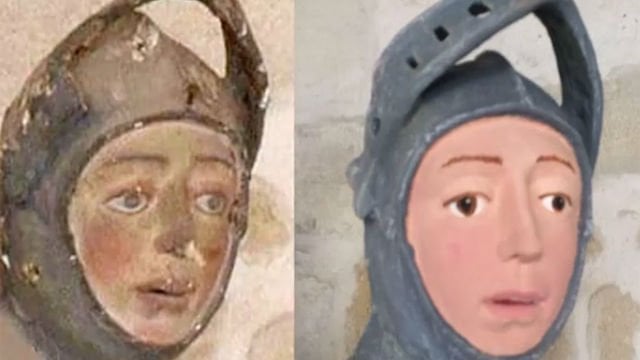
Before and after a misguided restoration on the statue of St. George at Navarre, Spain’s Church of San Miguel de Estella. Photo via Twitter.
When the Church of San Miguel de Estella in Navarre, Spain, set out to restore its 500-year-old statue of the legendary St. George, it wasn’t counting on becoming an internet-wide laughing-stock. But that’s exactly what was in store for the Disney-esque job done by a local teacher. The church and the company responsible were both fined €6,000 ($6,840).
Fortunately, after three months of work, at a cost to the church of $37,000, the artwork was successfully re-restored to its original appearance. “Today, the statue has the same colors it had before last year’s extremely unfortunate intervention. But we know that we’ve lost part of the original paint along the way,” said Carlos Martínez Álava, head of the Navarre government’s historic heritage department.
It was a guide at the Dunhuang grottoes in Gansu province who first took issue with the new paint job on a 1,000-year-old Song dynasty Buddha statue in China’s Anyue township. The amateur restoration job was carried out by local villagers back in 1995, but it wasn’t until Xu Xin shared pictures of the sculpture on Weibo in 2018 that the catastrophic paint job attained global notoriety.
The Anyue county government blamed the well-meaning villagers’ lack of conservation knowledge, and said that officials didn’t notice the new paint job until it was complete. “After the incident, the Administration of Cultural Heritage improved the management and protection of other relics,” according to a government statement. “No similar repair work was carried out again in recent years.”
The picturesque ruins of the 2,000-year-old Ocakli Ada Castle in the seaside town of Sile, Turkey, were utterly unrecognizable after a five-year restoration project was completed in 2010. The crumbling edifice was completely rebuilt with modern materials, creating a smooth and blocky appearance that looks like it’s straight out of the game Minecraft.
The work was roundly mocked on social media, with many comparing the castle’s façade to cartoon character Spongebob Squarepants. The town defended the work, telling the Daily Mirror “the criticism on social media is not based on knowledge and it disregards the developments and the decision made during the process of restoration.”
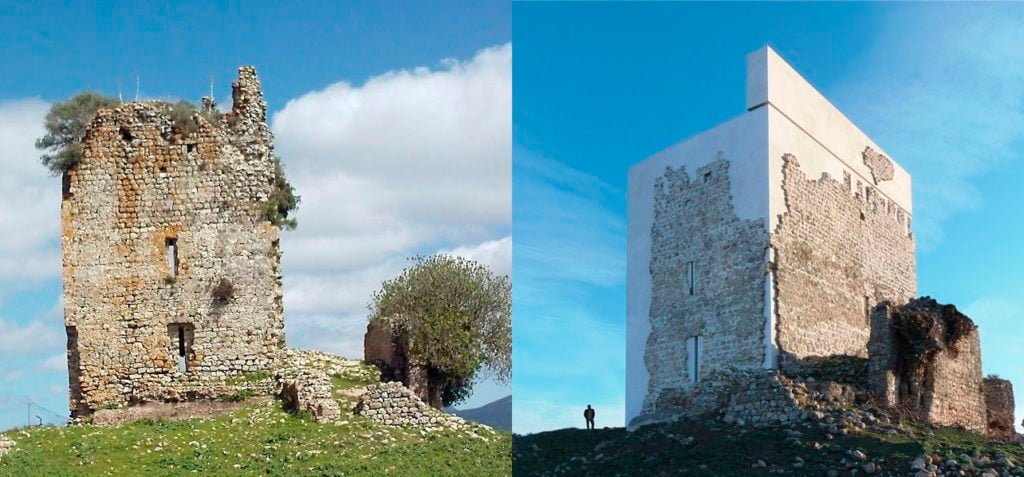
Spain’s Castle of Matrera, before and after restoration work was carried out by architecture firm Carlos Quevado Rojas. Photo by Leandro Cabello, courtesy of Carquero Arquitectura.
A similarly questionable effort was made by architectural firm Carlos Quevado Rojas in restoring the Castle of Matrera in Villamartin, Spain. After the ninth-century medieval fortress partially collapsed in 2013, restorers rebuilt and stabilized the structure—but the Historic Heritage Law bans mimetic reconstructions, which meant the firm had to use modern materials that were visually distinct from the existing ruins.
The result was an outlandish patchwork of old and new that drew outrage, with left-wing political group Izquierda Unida lodging a complaint with the Ministry of Culture. Meanwhile, the franken-castle’s bizarre appearance predictably went viral, and apparently became a renewed tourist attraction.
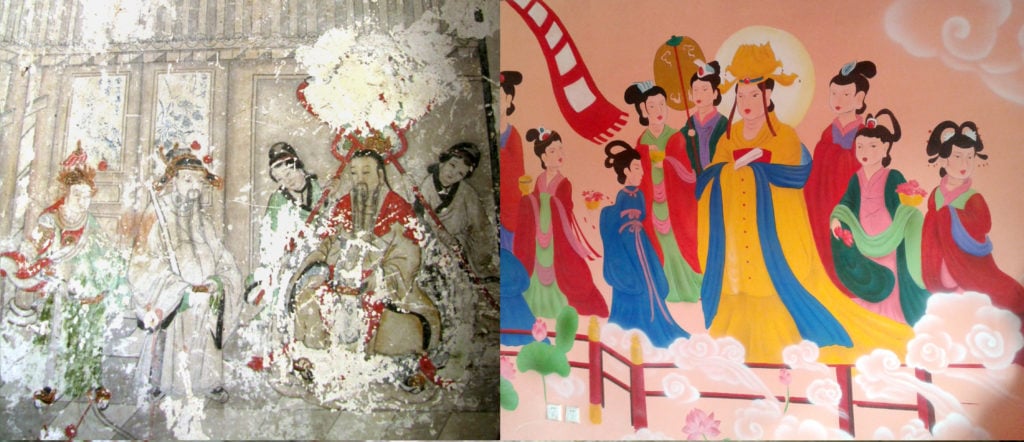
One of the ancient Buddhist frescos in Yunjie Temple in Chaoyang, northeast China, that has now been covered by cartoon-like paintings as part of a restoration. Photo courtesy of STR/AFP/Getty Images.
The ancient Buddhist frescos in China’s Yunjie Temple were in dire need of conservation work to preserve the flaking, disintegrating paintings. Unfathomably, in what is an all-too-familiar occurrence, the £100,000 job turned into a technicolor nightmare. New storybook-style paintings completely replaced the original Qing dynasty-era works.
The result amounted to nothing less than the “the destruction of cultural relics since the original relics no longer exist,” Wang Jinyu, an expert on fresco restoration from the Dunhuang Academy, told the Telegraph. In response, two government officials were fired, one of whom claimed it had been an the “unauthorized conservation project.”
A local craftsman, Mehmet Daşkapan, was the first to raise a red flag over restoration work being done at the Hatay Archaeology Museum in Antakya, Turkey, on mosaics from 2nd to the 6th centuries. The photos were damning, with the delicate figures appearing distorted and fine details lost.
The Culture and Tourism Ministry denied that there was any problem, claiming that the photos were taken during the initial phase of the restoration work, and that they would soon be restored to their original splendor. Restorer Celal Küçük also defended his work—but the pictures speak for themselves.
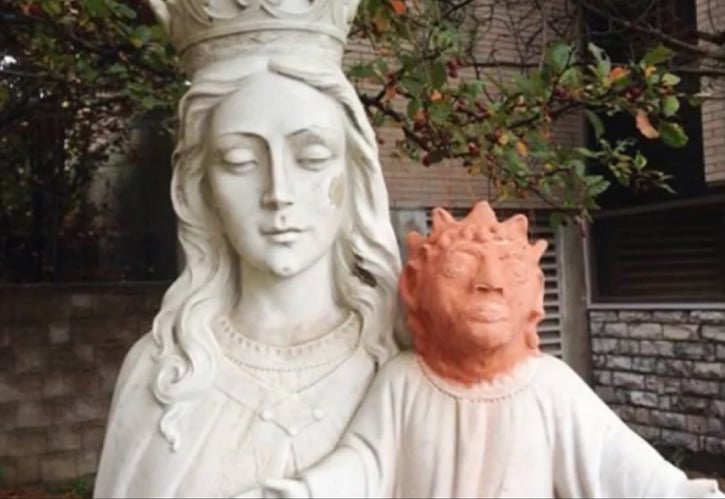
Heather Wise’s attempted restoration of a statue of Jesus. Screen grab via YouTube courtesy of Coisas da Net.
A Canadian church had a vandalism problem, with local hoodlums repeatedly decapitating a statue of Mary holding the baby Jesus. When the head finally disappeared for good, local artist Heather Wise offered to replace it free of charge—and the church happily accepted, given that her professional estimate was just $10,000 CAD ($7,300).
But what they got was a freakish, spikey-headed red monstrosity that became a Twitter sensation, often gleefully compared to Lisa Simpson. Wise claimed that the terracotta face, which soon began melting in the rain, was just a temporary placeholder while she carved a stone replacement, but thanks to the media attention, the penitent thief was moved to return the original head.
The church announced plans to clean and restore the statue, but admitted it had actually grown fond of the ridiculous red baby Jesus. Wise, however, wanted it back—it was her most famous work of art, after all.
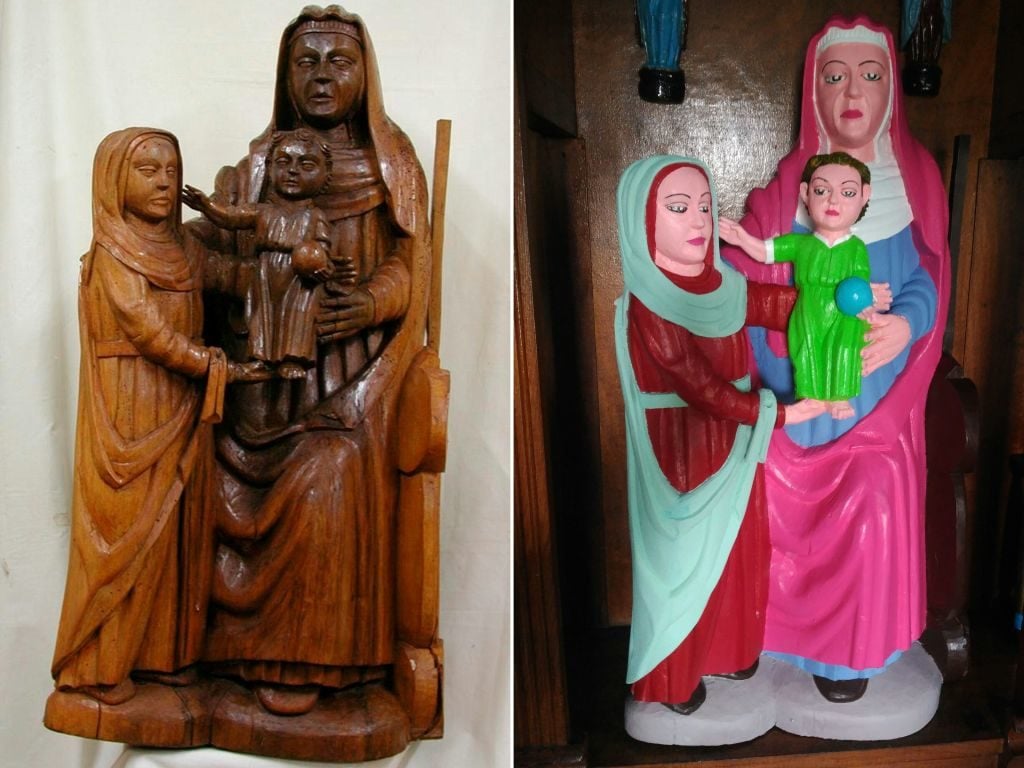
At left, the 15th-century statue of Virgin Mary before being “restored” (right) by a local woman in Asturias, Spain. Photo DSF/AFP/Getty Images.
In another case of a misguided church parishioner wreaking havoc on a beloved piece of religious art, Maria Luisa Menendez took it upon herself to jazz up a trio of 15th-century wooden sculptures with a fresh coat of paint. (One was originally unpainted.)
Even though the statues had been professionally restored just 15 years before, the parish priest apparently gave his blessing to the amateur. Her brightly colored efforts—she gave the Virgin Mary turquoise hair—were widely derided for their cartoonish appearance, and were also destructive to the original paint and patina.
“They’ve used the kind of industrial enamel paint they sell for painting anything and absolutely garish and absurd colors,” a local resident told Guardian. “The result is just staggering. You don’t know whether to laugh or cry.”

Restorers were accused of censoring the phalluses on the Tree of Fertility in Tuscany, Italy. Photo via Wikimedia Commons.
One of Italy’s most unique works of art, the Tree of Fertility, was uncovered in the year 2000 and is famous for its depiction of numerous phalluses—or at least it was, before a 2011 cleaning. The restorers who did the work were accused of censoring the historic fresco by removing about 25 dangling penis fruits from the previously laden branches.
“The restoration in no way radically modified the original features,” insisted Mario Scalini, the local province’s head of heritage and arts, telling the Telegraph that restoring the badly damaged fresco required the removal of salt and calcium deposits. “The operation was carried out with the greatest of care.”
A town official called for an investigation into the matter, but the damage was apparently done. Fortunately, recent photographs appear to show at least a few surviving penises.
In 2016, the world was shocked to discover that restorers had essentially paved over a 1.2-mile section of the Great Wall of China, built during the Ming Dynasty in 1381. To prevent the crumbling edifice from falling into further disrepair, workers poured a mix of lime and sand atop of the structure, completely disregarding the original crenelations and towers.
“This was vandalism done in the name of preservation,” said Liu Fusheng, a county park officer, at the time. “Even the little kids here know that this repair of the Great Wall was botched.”
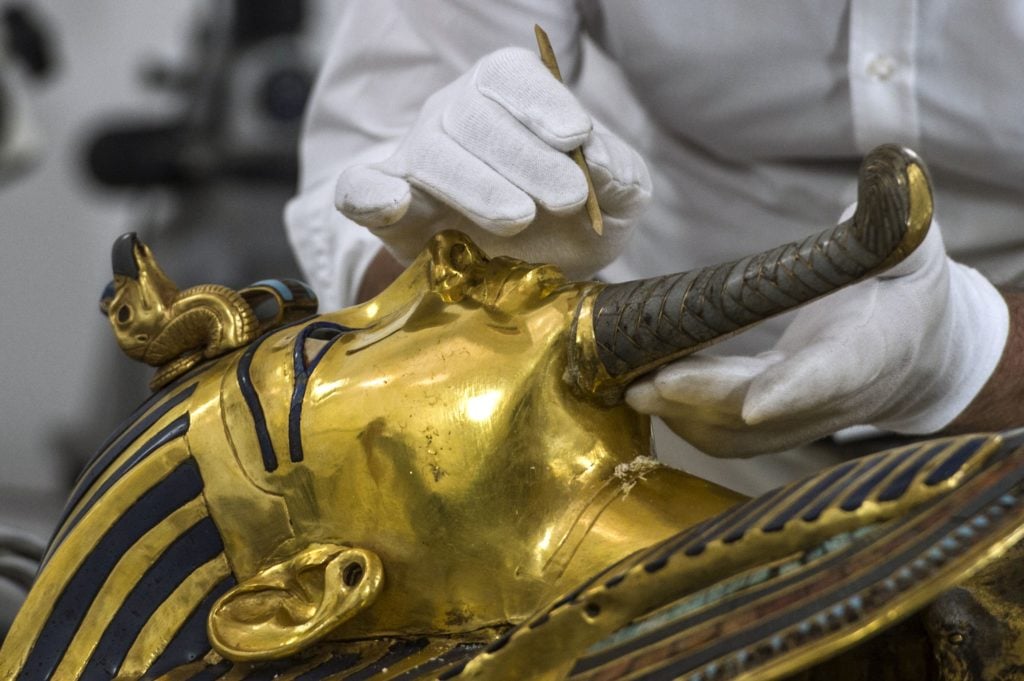
Christian Eckmann works on the restoration process of the golden mask of Tutankhamun at the Egyptian Museum in Cairo. Photo by Khaled Desouki/AFP/Getty Images.
When staff at Cairo’s Egyptian Museum snapped the beard off of the 3,300-year-old funerary mask of King Tutankhamun, they panicked and tried to quickly glue it back on—using industrial strength epoxy, in the middle of the gallery, during visiting hours. It was nothing short of a disaster, and the problem was only exacerbated when they tried to scrape off the glue, scratching the historic antiquity.
Those responsible faced disciplinary action for breaking protocol by not informing the Ministry of Antiquities about the accident, and for damaging the artifact. Fortunately, a German conservator was able to remove the glue and restore the mask.
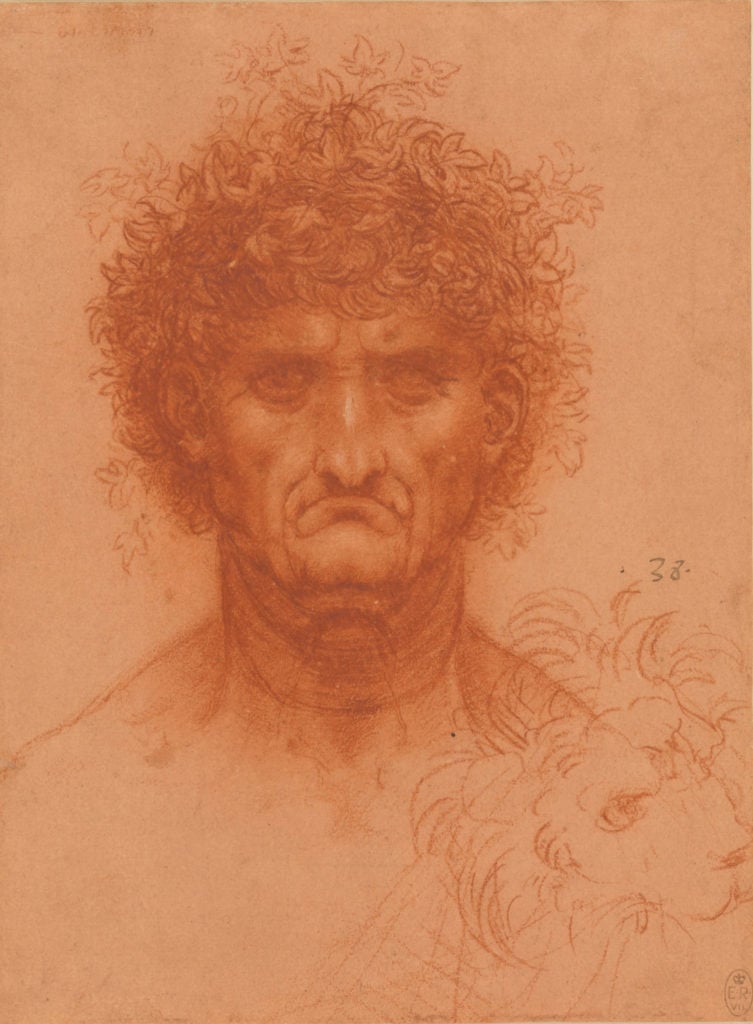
Leonardo da Vinci, Head of a Man, Full Face, and the Head of a Lion (ca. 1508). Courtesy of Her Majesty Queen Elizabeth II/Royal Collection Trust, via the Teylers Museum, Haarlem, the Netherlands.
You know it’s bad when no photos ever resulted to show a famous a work of art’s restoration. In 2001, Leonardo da Vinci expert Carlo Pedretti discovered a lost Leonardo drawing in the collection of one Stefano della Bella. The sketch, Orpheus Being Attacked by the Furies, was believed to have come from the Codex Atlanticus, compiled from various Leonardo notebooks by the sculptor Pompeo Leoni.
The good news was short lived. Pedretti soon announced that a team of colossally uninformed restorers had destroyed the historic artwork by treating it with water and alcohol without first testing the ink for solubility. Thanks to the boneheaded oversight, the delicate drawing disappeared. Writing in the Milan daily Corriere della Sera, Pedretti expressed his hope that chemical or nuclear experiments might recover the lost image, but the damage was sadly irreversible.
In undoubtedly the most famous example on this list, Cecilia Giménez put her small Spanish town on the map when her hilariously inept attempts to restore a religious painting of Jesus in the crown of thorns went viral. The 82-year-old had the best of intentions when she set to work on the rapidly deteriorating fresco, but her skills were not quite up to the task, to put it lightly.
The finished product, universally mocked as Beast Jesus or “Ecce Mono” (“Behold the Monkey”), had the unexpected result of turning Borja into a destination for tens of thousands of sightseers eager to behold the infamous restoration job for themselves. Giménez became an unlikely celebrity on the strength of the internet phenomenon, which inspired an opera and a documentary, and now has a dedicated art center, proving that even the worst art disasters can sometimes have a silver lining.